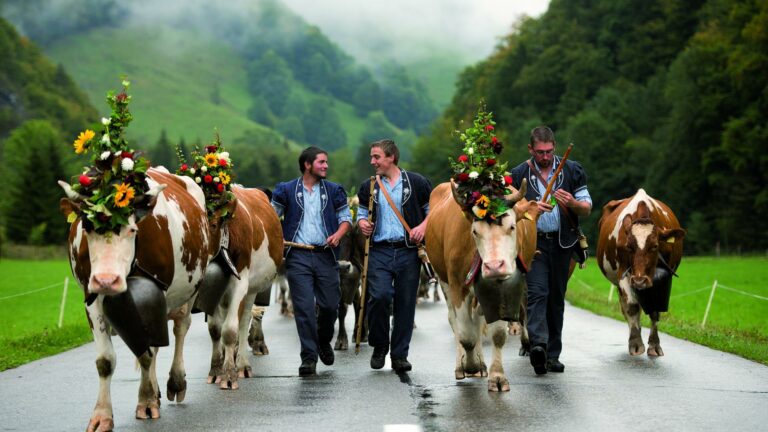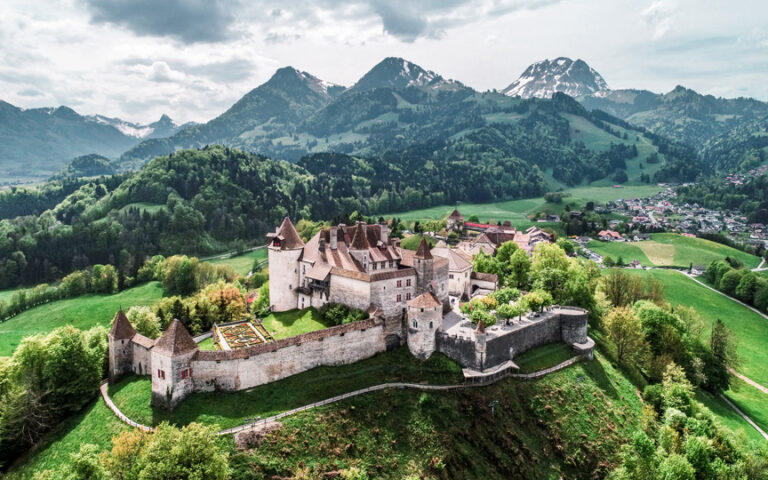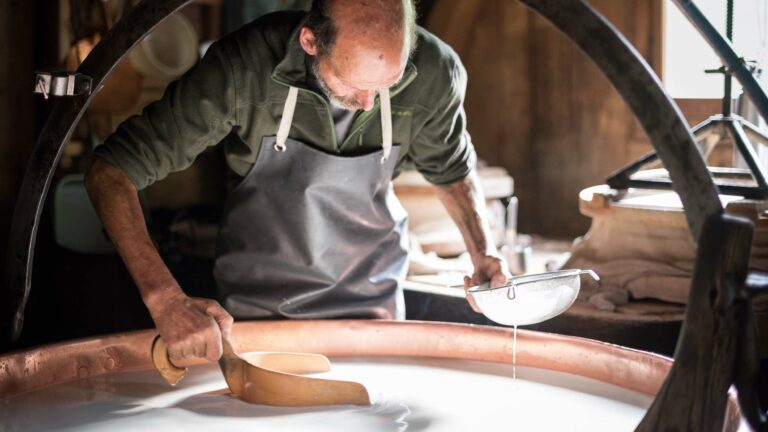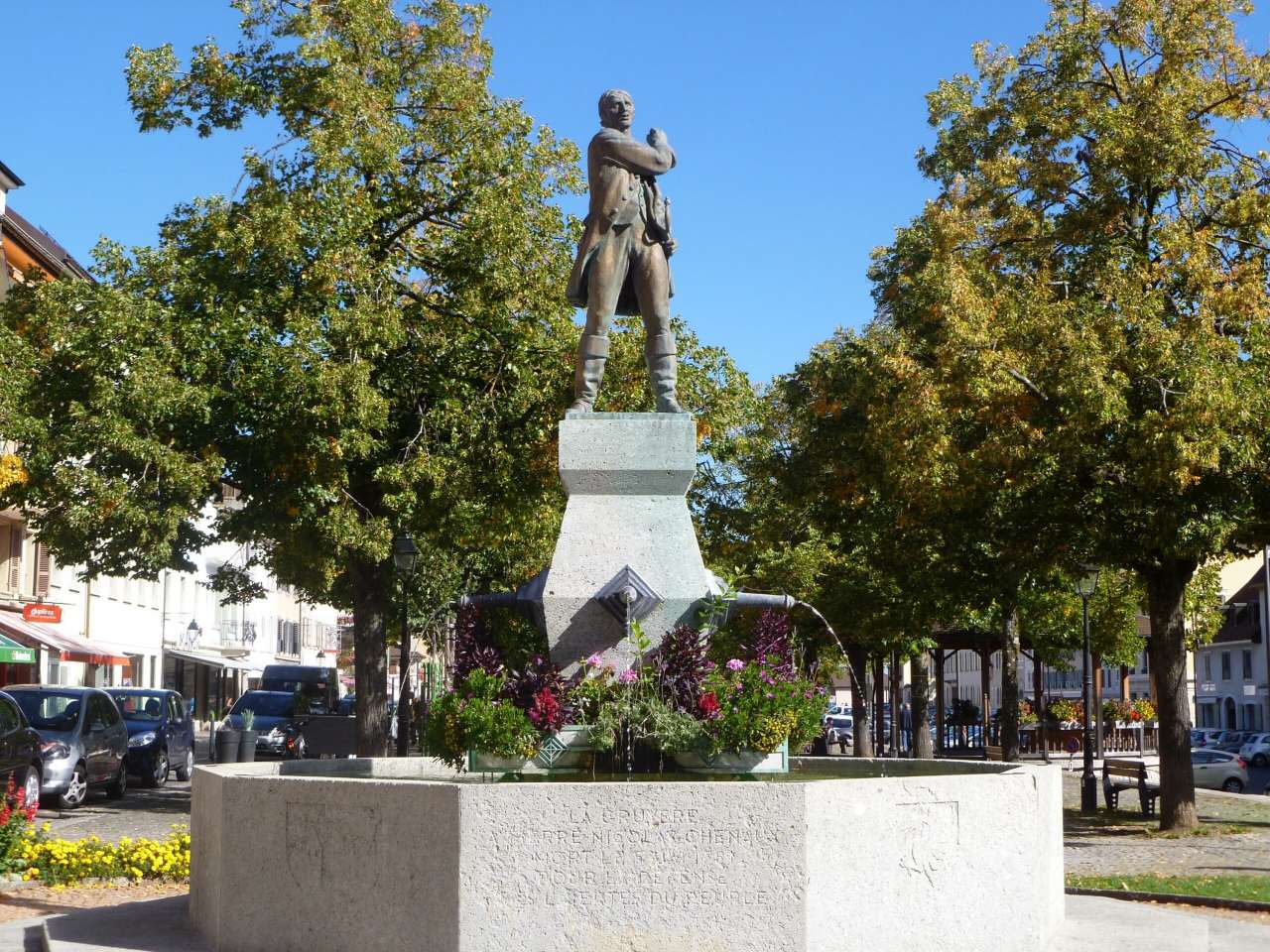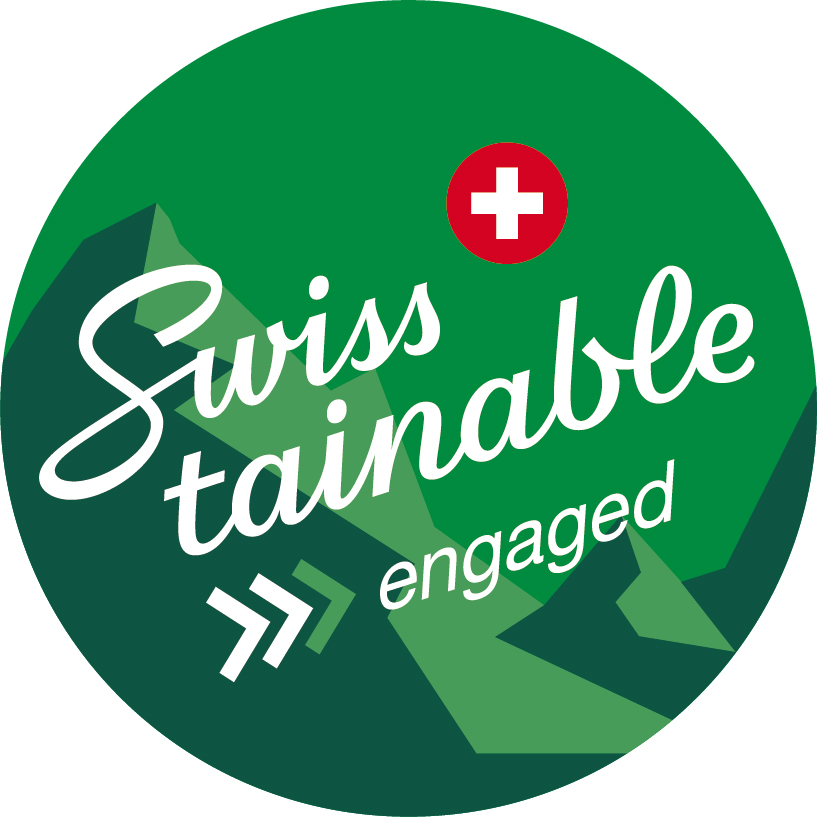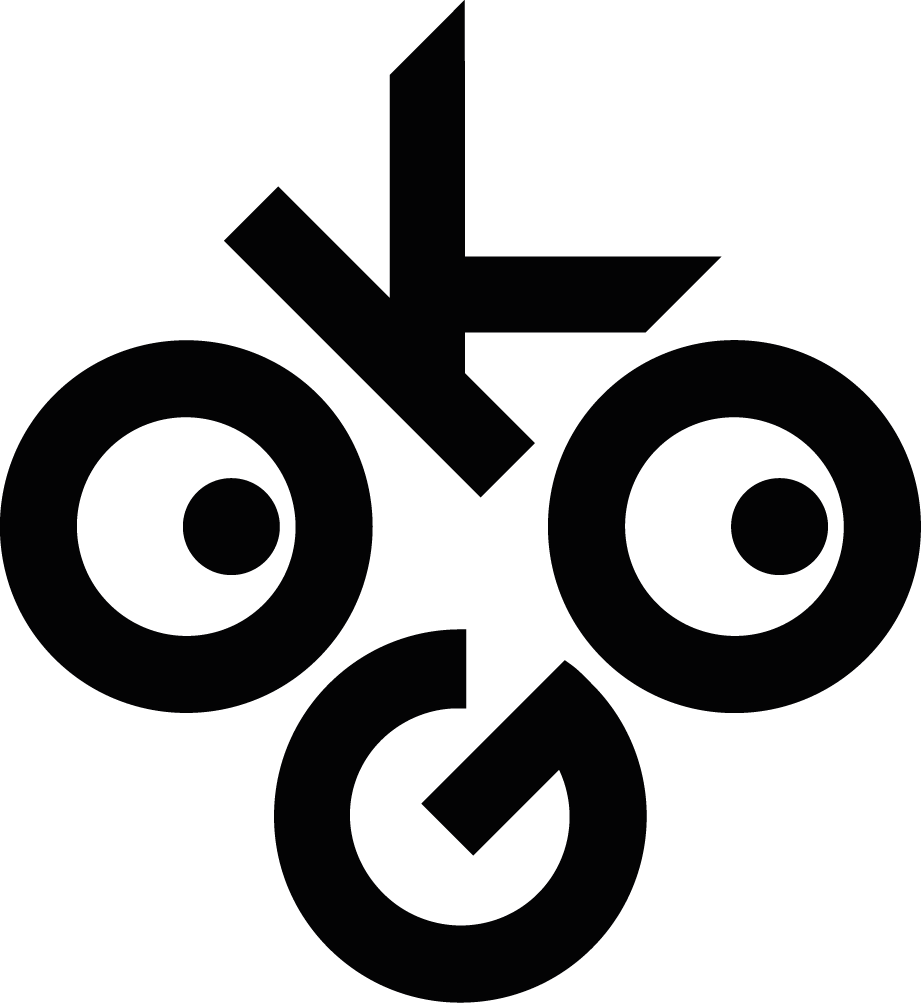This statue by the sculptor Carl Angst inaugurated in 1933 represents Nicolas Chenaux (1740-1781), from La Tour-de-Trême, who headed a popular revolt against the patrician government of Fribourg in 1781.
Just opposite the castle is one of the town’s thirty or more fountains. It is overlooked by a statue. Its subject, a man with a determined air, his fist raised in a sign of defiance, is Nicolas Chenaux, one of the historical personalities of the La Gruyère region. Nicolas Chenaux was born in 1740 into a well-off farming family in La Tour-de-Trême. An enterprising young man, he devoted his early years unsuccessfully to business (property, cheese, grain, mining and livestock breeding). Disappointed in his military ambitions too, he fared better at politics. His outspokenness and virulent criticisms ensured him undeniable popularity among the population.
Origins of the revolt
From 1780 to 1784, in the wake of economic, political and religious problems, the canton of Fribourg lived through a troubled period, the most spectacular manifestation of which was the Chenaux uprising (also known as the “Chenaux Revolution”) in 1781.
Nicolas Chenaux and his followers took issue with the oligarchic government of Fribourg for revoking around thirty religious festivals, abolishing the convent of La Valsainte and planning the introduction of new taxes. Chenaux promised his accomplices that their debts would be wiped out, that an agrarian law would be passed, and that farmers would be granted free ownership of the land they held under lease.
Thus it was that on 29 April 1781, Nicolas Chenaux headed a small band of men under the command of officers. Gathered in Bulle at the Auberge de l’Épée Couronnée (today the Hôtel du Cheval Blanc), Chenaux plotted a revolt and planned to take Fribourg by surprise. The date chosen was initially Saint-Jean (24 June), later brought forward to the festival of 3 May. However the Fribourg government, already alerted by similar cases elsewhere, was prepared. Forewarned of the plot, it ordered the arrest of Chenaux; however the latter, assisted by his informers, managed to escape the government’s clutches.
At the heart of the uprising
On 1st May 1781, Chenaux heard that Fribourg had put a price on his head. Instead of hiding or running away, he took the initiative, harangued the population and, on 2 May, made his way to the Fribourg capital. On 3 May the gates of the town stayed closed and bargaining took place; the assailants took this opportunity to rally two to three thousand country folk to their cause, while the besieged population started to panic and sent word to Bern for assistance. Fearing that the Fribourg uprising would give ideas to their French-speaking bailiffs, the authorities in Bern lost no time in sending their troops to assist their neighbour. Fribourg was therefore well prepared to face poorly armed and insufficiently organised farmers.
On 4 May 1781, the native of Vaud Benjamin Louis Monod de Froideville, a former Prussian officer in command of government troops, easily obtained the surrender of several hundred men. During the night of 4/5 May, after retreating to a wooded area, Chenaux was seized by one of his own men, tempted by the large reward promised for his capture. A fight broke out, as a result of which Chenaux was killed. His body was taken to the town of Fribourg, where he was publicly decapitated and dismembered.
Consequences
Shortly afterwards, the people flocked to his grave and declared him “Saint Nicolas Chenaux, Martyr of Freedom”. This somewhat rapid and spontaneous canonisation provoked the ire of the Church and was sharply condemned. Moreover, government repression against the rebels became extremely severe; prison sentences, orders to be sent to the galleys, banishments and fines were the lot of most insurgents.
At a political level the Fribourg authorities, encouraged by Bern, Lucerne and Soleure, opted for appeasement. Parishes and communities were invited to express their wishes in writing. None of the proposals emanating from the countryside contested the institution of the patriciate per se, but some requested a lightening of the tax burden and restoration of the recently abolished religious festivals and processions. However, the common bourgeoisie of the capital, through clever and insistent manoeuvrings, made it known that it aspired to an improved distribution of power with the privileged bourgeoisie. The conflict intensified; it came to a head in 1783 with the forced exile of their main representatives. The latter therefore joined survivors of the call to arms of 1781 abroad. Some welcomed the French Revolution of 1789 and returned to the country in 1798.
A victim of the infamous procedure of “damnatio memoriae” (banishment from memory), recollections of Chenaux gradually faded. It was not until 1848 that the radical political wing rehabilitated him officially. In 1933, this monumental statue was erected in Bulle, on the Market Square, in honour of the “Defender of the people’s freedoms”.
The day after Chenaux’s death, to bolster its repression, the Fribourg government ordered the sign of the Auberge de l’Épée Couronnée, the former headquarters of Chenaux, to be taken down and burnt on the public square, in order to discourage once and for all the most virulent enemies of Fribourg. Even though its visible manifestation disappeared, the ideology and spirit of opposition remained. And it did not stop the inhabitants of Bulle from reopening the establishment under a new name, the Cheval-Blanc, nor from adorning the new sign with a sword crowned with laurel leaves pointing towards Fribourg, in memory of the events of 1781.
Many of Chenaux’s allies exiled in France continued to oppose the Ancien Régime in their capacity as members of the Club Helvétique in Paris (1790-1791). One of the aims of that society, namely to carry revolution to the Swiss cantons, was successful in 1798 with the invasion of the country by the French Army and the creation of a Swiss Republic founded on the new ideals of individual freedom and equality, centralised on the French model.
© Musée gruérien
Carl Albert Angst
Carl Albert Angst (1875-1965), from Geneva, was the son of a cabinetmaker. He was a skilled engraver and sculptor of wood (including Art Nouveau furniture) in Paris from 1896 to 1911, firstly with Jean-Auguste Dampt and then as a self-employed tradesman from 1903. Throughout this time he drew and sculpted, mainly portraits of children. He won a prize for a planned Swiss national monument on the theme “The Age of Heroes” in 1909. A teacher at the School of Industrial Arts of Geneva (1911-1913) and a member of the Federal Commission of Fine Arts (1916-1918, 1927-1930), he produced sculptures for public squares, as well as busts and medallions (Barthélemy Menn, Ferdinand Hodler), the frame of the station clock in Lausanne, and the symbol of Justice for the frontispiece of the Federal Court and three of its portal adornments. Carl Albert Angst sometimes drew inspiration from Greek and Egyptian art. He was influenced greatly by Auguste Rodin, with whom he shared a taste for psychological symbols and allusions. A large number of his works disappeared when a warehouse owned by the Museum of Art and History in Geneva caught fire in 1987.
© Dictionnaire historique de la Suisse
Find out more
Georges Andrey, “Le monument Chenaux, la fête, le symbole”, in La Fête, Cahiers du Musée gruérien, n°1, 1997.
Georges Andrey, “La révolution Chenaux”, in Pouvoirs et territoires, La Gruyère dans le miroir de son patrimoine, T. 3, Editions Alphil, 2011.
Alain-Jacques Tornare, “Révolution française et Contre-révolution. Impacts en Gruyère (1781-1815)”, in Pouvoirs et territoires, La Gruyère dans le miroir de son patrimoine, T. 3, Editions Alphil, 2011.
Serge Kurschat, «Pierre-Nicolas Chenaux : le révolté gruérien», Éditions Montsalvens, 2017, 208 p.
Serge Kurschat, «Les patriciens fribourgeois face à l'insurrection Chenaux», Passé Simple, mensuel romand d'histoire et d'archéologie, no 17, septembre 2016, p. 24-25.
Serge Kurschat, «Pierre-Nicolas Chenaux, Etude d'un processus révolutionnaire en Gruyère à la fin du XVIIIème siècle», 2015, 365 pages.
N.B.: mémoire de Master sous la direction du Pr.Dr. Edmond Dziembowski, Université de Franche-Comté, Faculté des lettres et sciences humaines, UFR Sciences du langage, de l'homme et de la société, France.
Also of interest
The sign of the Hôtel du Cheval Blanc, formerly the Auberge de l’Épée Couronnée, the headquarters of Chenaux.
Models of the statue and the “urn containing the skull of Pierre-Nicolas Chenaux”, in the section “Contours in motion” of the permanent exhibition La Gruyère, footprints and detours, at the Musée gruérien.
Archive photo:
Inauguration of the Chenaux monument, 1933. On the left in the bowler hat is Jean-Marie Musy, Fribourg’s first federal councillor from 1919 to 1934.
© Photo Glasson Musée gruérien
1630 Bulle





